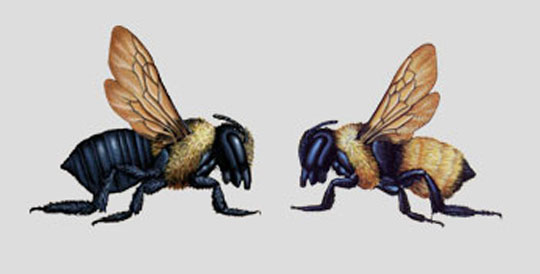Is It a Carpenter Bee or Bumble Bee?
By Chris Williams on June 4, 2013.
Question
How can you tell a carpenter bee from a bumble bee? We’ve been seeing lots of big, black and yellow bees around our house and I’m concerned that they might be damaging the wood somewhere. We can’t find any kind of nest.
Answer
While carpenter bees and bumble bees do look somewhat alike, you can tell them apart. Both collect pollen to feed to their young, but their nest sites and habits are quite different.
Look at the abdomen
Both bees are about the same size (almost 1 inch) and both are black and yellow. The easiest way to tell the difference is that the top of our eastern carpenter bee’s abdomen is black, shiny, and hairless, while the bumble bee’s abdomen is fuzzy black, often with a yellow band.
Nest sites are different
Carpenter bees nest in pairs in soft, weathered, unpainted woods like cedar decks, soffits, eaves, and wooden siding. The hole into the nest gallery in the wood is about the size and shape of a shirt button. Inside the gallery, the female provisions several cells with pollen balls and lays an egg in each. The male aggressively guards the nest during spring construction; after construction and egg laying, both bees leave the area.
Bumble bees are social bees that live in a colony. A new queen starts a new colony in the spring. She lays eggs and raises the first brood of worker bees. The new workers then take over nest duties, collecting pollen to feed to the larvae in the nest, and rearing the next brood of workers. Nests continue to grow until late summer. Nest entrances are usually a hole in the ground, but nests can also be in old equipment, in logs, in sheds, in building voids, or in other unusual places.
There may be a good reason why you can’t find the nest. Carpenter bees often make their nest openings on the backside or underside of the wood, where wood is unpainted or unfinished. On fascia boards, for example, the entrance hole is likely not even visible from the front. And bumble bees often hide their ground nest opening under a tuft of grass or a plant, or they will use an abandoned rodent’s burrow.
Different life styles, different habits
If your bees are carpenter bees, the adults should be pretty much gone now. The developing larvae emerge as bees in late summer but they won’t construct new nests until next year. If your bees are bumble bees, that nest should just be getting going about now and the number of bees will increase all summer.
You said you were seeing “lots” of bees. It could be that you were seeing the same pair (or two, or three) of carpenter bees. Although they are not social bees, more than one pair often nests in the same area and they are very active during nest building. You also could be seeing worker bees that are foraging from a growing bumble bee nest.
Let the pros help— give Colonial a call. Our technicians should be able to find evidence if there have been carpenter bees nesting on or around your home. They can also inspect for foraging bumble bees and can track the bees back to their nest site. Bumble bees are beneficial pollinators and control is usually not recommended unless the nest is in a location where children or pets might disturb the bees and get stung.
